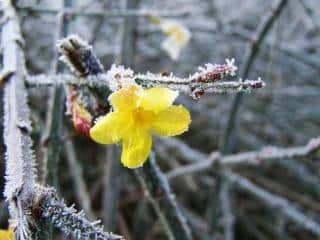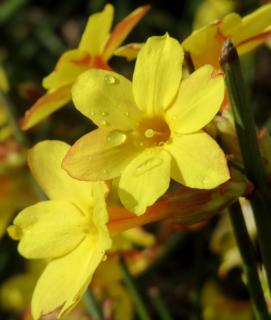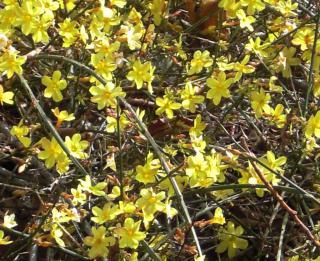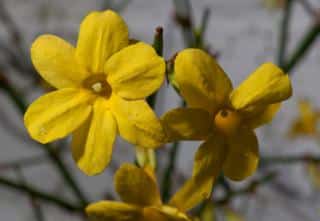

Winter jasmine is one of the brightest winter flower vines.
Winter Jasmine facts
Name – Jasminum nudiflorum
Family – Oleaceae
Type – climbing vine, indoor plant
Height – 3 to 6 ½ feet (1 to 2 meters)
Exposure – light
Soil: soil mix – Foliage: evergreen – Flowering: winter, early spring
Care, from repotting to pruning and including the watering is a set of proper actions that will help you grow magnificent jasmine.
Hardy winter jasmine grows in most of our regions and climates.



In order to favor the following blooming, you should cut all stems back by 4 to 10 inches (10 to 25 cm) while keeping a harmonious silhouette.
After that, every month until fall, pinch new stems to create new ramifications which will lead to denser, more abundant blooming.
Adequate watering is required for the winter jasmine to bloom well. This is a plant that needs water but for which excess water can sometimes be detrimental, especially in fall.
This is the time frame where water needs are at their highest.
Abundant watering 2 to 3 times a week is appreciable for winter jasmine, especially if temperatures are high.
Start with slowly reducing the watering frequency, in the end only watering once a week in winter.

Even though it is the hardiest of all jasmine varieties, and thus the most able to resist cold, it can only stay outdoors in mild-climate areas. Its hardiness to freezing stands down to 5°F (-15°C).
Elsewhere, for example in mountainous areas, it should be grown in pots to be able to put it away during the fierce winter frost.
The plant loves being outside, even though it fears spots that may be too hot or too sunny.
Better to go for slightly covered sun.
Indoors, don’t place your jasmine directly behind a window in direct sunlight, or it could dry up too fast. Protect it from direct rays of the sun.
Jasmine needs up cool temperatures in winter for it to bloom, so it should be put in a room where temperatures don’t exceed 60°F (15°C). This isn’t really an indoor apartment plant.
Winter jasmine is a plant that doesn’t smell anything, unlike the other types of jasmine that are part of the ingredients used for perfume.
However, it is a beautifully blooming climbing vine.
Lastly, jasmine bears fruits, small berries that turn black when ripe, which aren’t edible.
There are two types of jasmine: winter jasmine bearing yellow flowers and summer jasmine or star jasmine which has white flowers.
Read also:
Winter jasmine still is great for indoor growing, as long as it can stay in cooler premises over the winter!